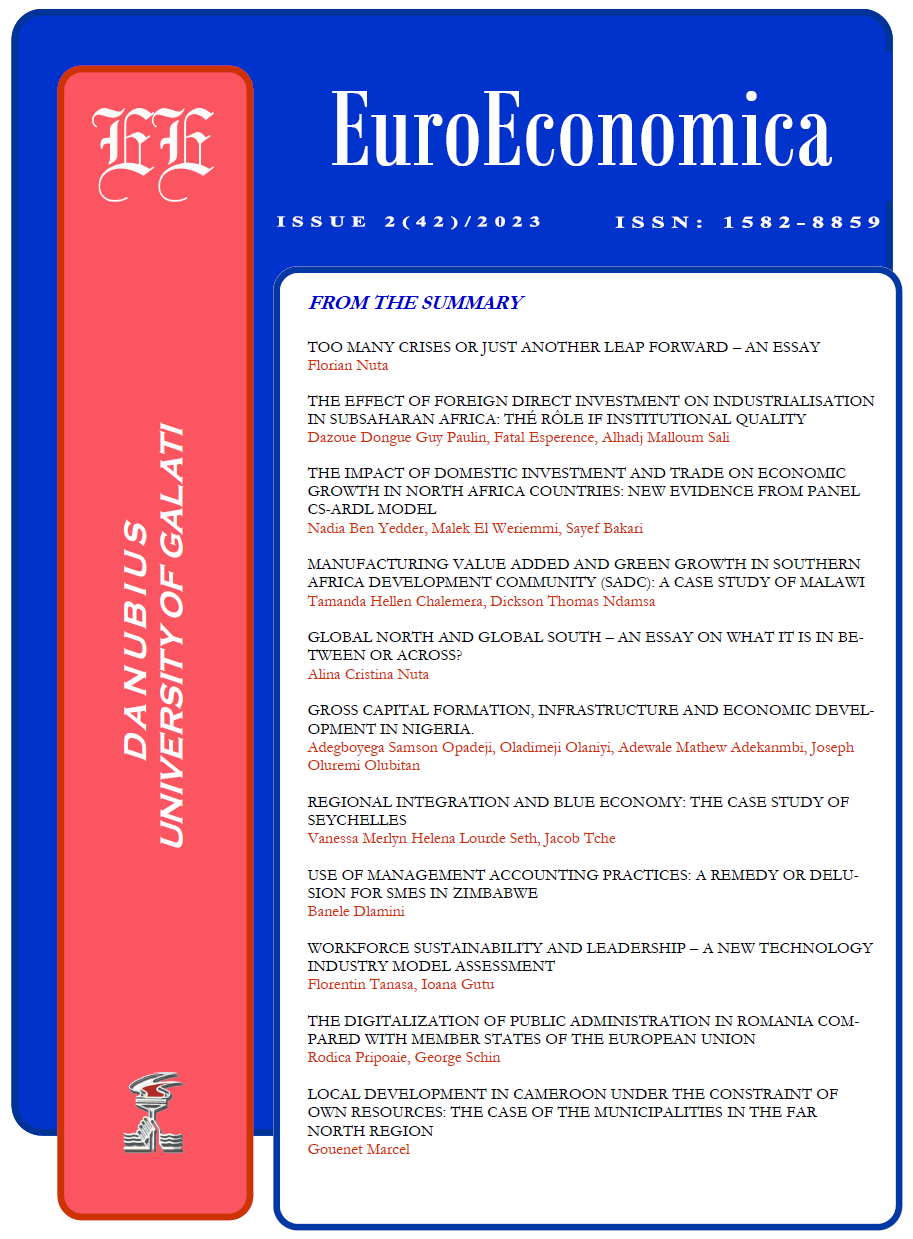The Effect of Foreign Direct Investment on Industrialisation in Subsaharan Africa: thé Rôle if Institutional Quality
Keywords:
foreign direct investment, industrialisation, sub-Saharan Africa, institutionsAbstract
This study examines the relationship between Foreign Direct Investment (FDI) and industrialisation through the role played by the quality of institutions. It examines the effect of FDI on industrialisation for a sample of 39 sub-Saharan African countries over the period 2006-2019. The estimation techniques are based on Dynamic Least Squares (DOLS) and Fully Modified Least Squares (FMOLS) methods. On the one hand, the results of the estimates show that FDI does not contribute directly to the industrialisation of sub-Saharan Africa, but does have a positive and significant impact on industrialisation. On the other hand, foreign direct investment contributes to the industrialisation of sub-Saharan Africa through the role played by the quality of the institutions in place. This positive and significant effect is a characteristic of the sub-Saharan African region, but varies from one country to another. These differences are mainly explained by the availability of natural resources and the varying quality of existing institutions in the different countries. Based on these results, sub-Saharan African countries should establish a strong link with foreign direct investment and promote industrialisation through quality institutions in order to ensure adequate structural transformation.
References
Alfaro, L.; Chanda, A.; Kalemli-Ozcan, S. & Sayek, S. (2004). FDI and economic growth: the role of local financial markets. Journal of international economics, 64(1), pp. 89-112.
Amara 2, M. & Thabet 3, K. (2012). Structure industrielle et développement local du littoral tunisien, 1998-2004 1. Monde en développement, (1), pp. 119-136.
Arellano, M. & Bond, S. (1991). Some Tests of Specification for Panel Data: Monte Carlo Evidence and an Application to Employment Equations. Review of Economic Studies, 58, pp. 277-297.
Arellano, M. & Bover, O. (1995). Another Look at the Instrumental-Variable Estimation of Error-Components Models. Journal of Econometrics, 68, pp. 29-52.
Banque Mondiale (2014). Flux d’investissements directs étrangers en Afrique Subsaharienne, dans Sciences, technologie et compétences pour le développement de l’Afrique. Working Papers, pp. 1-4.
Bouoiyour, J. & Toufik, S. (2007). L’impact des investissements directs étrangers et du capital humain sur la productivité des industries manufacturières marocaines. Région et développement/ Region and development, 25, pp. 115-136.
Di Maio, M. (2009). Industrial Policies in Developing Countries: History and Perspectives.
Graham, E. & Krugman, P. (1995). Foreign Direct Investment in the United States. Washington.
Graham, P. (2000). Building education for the next industrial revolution: teaching and learning environmental literacy for the building professions. Construction Management & Economics, 18(8), pp. 917-925.
Gui-Diby S. & Renard, M. F. (2015), Foreign Direct Investment Inflows and the Industrialization of African Countries. World Development, 74, pp. 43-57.
Hanson, G. H. (2001). Scale economies and the geographic concentration of industry. Journal of Economic Geography, 1(3), pp. 255-276.
Kang, S. & Lee, H. (2011). Foreign Direct Investment and Deindustrialization. The World Economy, 56, pp. 313-329.
Kao, C. & Liu, S. T. (2000). Fuzzy efficiency measures in data envelopment analysis. Fuzzy sets and systems, 113(3), 427-43KAYA, Y. (2010), Globalization and Industrialization in 64 Developing Countries: 1980‑2003. Social Forces, 88, pp. 1153-1182.
Kriaa, I.; Ettbib, R. & Akrout, Z. (2017). Investissements Directs Etrangers et industrialisation de l’Afrique Foreign direct investment and industrialization of Africa. Int J Innov Appl Stud, 21(3), pp. 477-491.
Lalwani, M. (2002). The impact of foreign direct investment on domestic savings and investment in select developing economies. International Studies, 39(1), pp. 79-87.
Lichtenberg, F. R. & De La Potterie, B. V. P. (1998). International R&D spillovers: a comment. European Economic Review, 42(8), pp. 1483-1491.
Lionnet, F. & Bruno, E. (2016). Literary Routes: Migration, Islands, and the Creative Economy. Pmla, 131(5), pp. 1222-1238.
Liu, Z. (2002), Foreign Direct Investment and Technology Spillover: Evidence from China. Journal of Comparative Economics, 30, pp. 579-602.
Majeed, M. & Ahmad, E. (2008). Human Capital Development and FDI in Development Countries. Journal of Economic Cooperation, 29, pp. 79-104.
Marchand, L. & Lauzon, N. (2004). L’apprentissage en ligne en milieu manufacturier: une valeur ajoutée? Gestion, 29(4), pp. 59-66.
Markusen, J. & Venables, A. (1999), Foreign Direct Investment as a Catalyst for Industrial Development. European Economic Review, 43, pp. 335-356.
Mayer, T. & Mucchielli, J. L. (1999). La localisation à l’étranger des entreprises multinationales. Une approche d’économie géographique hiérarchisée appliquée aux entreprise japonaises en Europe. Economie et statistique, 326(1), pp. 159-176.
Mucchielli, J. & Mayer, T. (2005). Economie Internationale. Paris, Dalloz.
Nguyen, B. D. (2010). Stratégie industrielle des pays asiatiques en transition: le cas du Vietnam. Doctoral dissertation. Paris 13.
Onudi (2002). Rapport de l’ONUDI sur le développement industriel 2002-2003: l’Afrique handicapée par son retard technologique. New York.
Page, J. (2010). Should Africa Industrialize? Washington: The Brookings Institution.
Page, J. (2012). Can Africa Industrialize? Journal of African Economies, 21, pp. 86-125.
Potterie, B. V. P. D. L. & Lichtenberg, F. (2001). Does foreign direct investment transfer technology across borders? Review of Economics and statistics, 83(3), pp. 490-497.
Rostow, W. W. (1960). The Five Stages of Growth--A Summary, pp. 4-16.
WDI (2015). World Development Indicators. Base de données de la Banque mondiale.
World Bank. (2000). World development report 2000/2001: Attacking poverty. The World Bank.
You, K. & Solomon, O. (2015). China’s Outward Foreign Direct Investment and Domestic Investment: An Industrial Level Analysis. China Economic Review, 34, pp. 249-200.
Younsi, M. & Bechtini, M. (2019). Do institutions and good governance affect inward FDI? Empirical evidence from emerging countries.
Zhang, Y. J.; Liu, Z.; Zhang, H. & Tan, T. D. (2014). The impact of economic growth, industrial structure and urbanization on carbon emission intensity in China. Natural hazards, 73, pp. 579-595.
Downloads
Published
How to Cite
Issue
Section
License
Copyright (c) 2023 DAZOUE DONGUE GUY PAULIN, FATAL ESPERENCE, ALHADJ MALLOUM SALI

This work is licensed under a Creative Commons Attribution-NonCommercial 4.0 International License.
The author fully assumes the content originality and the holograph signature makes him responsible in case of trial.


